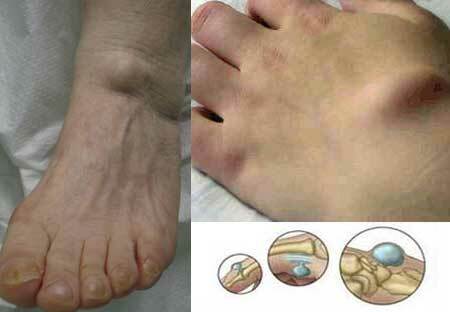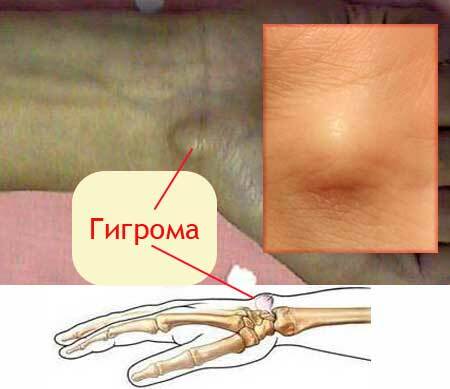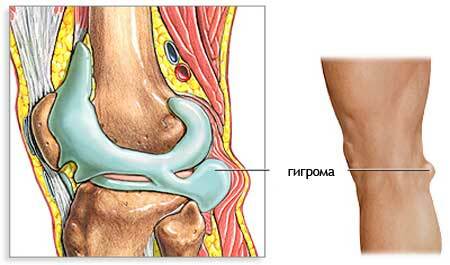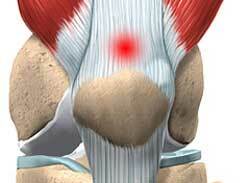Once appeared "bumps" in the region of the joints of the wrist and fingers, on the foot can for a long time not to give the person worry. In such cases, most often we are talking about gigrom.
The doctor is usually treated in cases where the compaction begins to increase in size and hurt. And the most imprudent option is to listen to "all-knowing" acquaintances and start squeezing out the hygromous. The terrible pain and risk of inflammation of the joint is almost inevitable. What is a hygroma, how to properly treat it - this knowledge will allow you to get rid of trouble in time and avoid its reappearance.
Contents of
- 1 Hygroma - what is it?
- 2 Causes of hygroma, symptoms
- 3 Hygroma of wrist and fingers
- 4 Hygroma on the leg( knees, feet, toes)
- 5 Hygroma in children - features of
- 6 Hygroma treatment - techniques, operation
- 6.1 Forecast
Hygroma - what is it?

Hygroma is a cystic densification that forms near the joint and is benign. The formation is surrounded by a dense shell associated with the synovial articular bag or vagina, and is filled with serous fluid.
When taking it for microscopic examination( puncture of the hygroma), mucus and fibrin inclusions can be detected, which gives the cyst content a jelly-like character. The cystic cavity is always connected to the synovial bag.
Most often, the hygroma forms in the area of the wrist joint, somewhat less often - on the fingers and toes and in the ankle. Very seldom cystic formation is formed in the armpit, on the knee joint and elbow.
In this case, one or several seals( multi-chamber hygroma) with a diameter of up to 3 cm are found. The cystic formation is difficult to touch due to fixation to the joint bag.
Usually, the cyst grows extremely slowly, but there is a rapid increase in size due to the effect of provoking factors( trauma, inflammation).
Hygroma is diagnosed at any age and in most cases is not a threat of cancerous degeneration. Delivering aesthetic discomfort, hygroma even small sizes can cause pain and problems with wearing shoes.
Causes of hygroma, symptoms of

hygroma photo of
There is no certain cause of hygroma origin. There are several theories in the medical community:
- Inflammation - a scar forms in the place of damage( rupture) of the synovial bag, but uneven loading leads to uneven protrusion of the envelope and its exit from the tendon capsule.
- Tumor - the hygroma is perceived as a benign neoplasm with uncontrollably dividing cells of the synovial membrane. At the same time, the growth of atypical cells is directed to the tissues surrounding the joint.
- Dismetabolic - the synovial fluid synthesis process is disrupted. Its increased secretion leads to the bulging of the capsule and the formation of cystic formation.
To the formation of hygromas predispose:
- The monotonous activity associated with fine motor skills - working at a computer, sewing and embroidery, playing musical instruments( piano, violin);
- Fractures, bruises and dislocations( especially with inferior treatment and insufficient rehabilitation) - Excessive stress on the joint leads to damage to the joint bag;
- Long microtraumatic joints - playing tennis, badminton, golf;
- Hereditary predisposition - frequent dislocations and inflammatory joint diseases in relatives in previous generations.
- It is not uncommon for a hygroma to occur for no apparent reason.
The disease is manifested by a small compaction of round or irregular shape. Characteristic signs of hygroma:
- Clear connection to the joint - sealing is inactive;
- Small sizes - from 5 mm the tumor grows to 3 cm, hygromes of 5-6 cm are rarely diagnosed;
- Skin over the tumor is not changed;
- Neoplasm is painless, aching pain occurs when pressing.
Depending on the location of the tumor-like formation, the above symptoms are joined by specific symptoms.
Hygroma of wrist and fingers
 In addition to the aesthetic discomfort of the hygroma on the arm, especially when reaching a larger size, it can cause compression of nearby vessels and nerves.
In addition to the aesthetic discomfort of the hygroma on the arm, especially when reaching a larger size, it can cause compression of nearby vessels and nerves.
The seal can move under the skin along with the vagina of the joint or be immobile, provided it grows out of the synovial capsule. With prolonged pressure on the cyst, formed from the capsule of the joint, a small depression forms on the surface.
Special features of hygromas of different locations:
Wrist hygroma ( rear or palmar joint surface) - occurs most often. With growing compaction, it is possible to squeeze the radial artery, which is manifested by increasing pain in the thumb.
Treatment of wrist hygroma without surgery by home remedies is fraught with an increase in tumor size and compression of nerves.
The ulnar nerve injury is manifested by the growing part of the middle finger, the little finger and the ring finger accentuated by prolonged flexion and numbness of the skin. With compression of the radial nerve, sensitivity decreases in the large, index and middle fingers.
The posterior interosseous nerve gives a decrease in sensitivity on the back of the wrist and hand. The compression of the palmar nerve leads to a low skin sensitivity of the large, middle, index finger and the part of the palm beneath them.
Cystic formations on the rear of the hand - reach no more than 2 cm. Growing from articular capsules( wrist and carpometacarpal joints), such hygroma on the hand is fairly dense and practically immobile. Compression of nerves and blood vessels occurs extremely rarely.
Hygroma of fingers - often multiple, small, immovable formations, capable of forming over the entire length of the fingers. They cause strong feelings in the person in terms of aesthetics and reduce efficiency.
Hygroma on the leg( knees, feet, toes)

The hygroma on the foot can be formed both on the large knee joints and on the small( foot).The symptomatic picture depends on the localization of cystic education.
Hygroma of the knee ( cyst of Baker) is the result of a long-term current arthrosis or rheumatoid arthritis, possibly its appearance after untreated intraarticular bruises. In the popliteal, less often lateral area of the joint, a rounded seal with a size of up to 10 cm is formed.
In the popliteal fossa, the hygroma is poorly palpated. Prolonged compression of the hygroma leads to its temporary softening: the cystic fluid migrates into the joint cavity.
Baker's cyst reduces the angle of knee flexion. When flexing with the use of force, there is weakness of the calf muscles."Running" shivers alternate with growing pain, the skin pales. A similar picture indicates a compression of the greater and peroneal nerves, the popliteal artery.
Hygroma of the foot - weakness of the foot with flat feet often leads to the formation of capsular cysts on the sole. Very dense, immobile formations are often perceived as bony growths.
Cystic education on the ankle - arise against a background of serious injuries( rupture of the tendon, sprain, sprains).The clinic for vasoconstriction does not appear due to the developed circulatory system.
Probably compression of nerves, leading to a decrease in motor activity( weakness) and partial loss of sensitivity in the foot.
Hygroma on the toe - initially a painless seal is squashed by the shoes when walking. Traumatization leads not only to the appearance of aggravated pain when moving, but also to the inflammatory reaction of surrounding tissues.
The skin over the hygroma blushes, there is swelling and a slight increase in the local temperature. Even a slight increase in such a tumor is fraught with the compression of nerves and blood vessels.
Hygroma in children - features of
 The appearance of cystic joints in the joints in children is associated with either low or excessive physical activity. Elastic tendons and ligaments in childhood are most likely to be stretched, and muscle weakness leads to an even greater strain on the joint.
The appearance of cystic joints in the joints in children is associated with either low or excessive physical activity. Elastic tendons and ligaments in childhood are most likely to be stretched, and muscle weakness leads to an even greater strain on the joint.
Hygroma in childhood is more often formed on the back of the wrist and palmar surface of the wrist, under the knee or on the sole. Intrauterine formation by gigrom is not excluded. Treatment gigrom without surgery is impossible even in children.
In any case, surgical excision is necessary: at the age of 10 years - under general anesthesia, in older children - with local anesthesia.
Treatment of hygroma - techniques, operation

No matter how much a man with a hygroma would like, it is impossible to avoid surgery. No drug can not even reduce the size of the cyst. Only surgical removal of the hygroma precludes its re-emergence and prevents the development of purulent bursitis / tendovaginitis.
- Crushing of hygroma
Especially dangerous is to use the technique of crushing the cyst. In the best case, the cystic fluid will move to the joint cavity, and after a while the hygroma will reappear.
In the worst case of such treatment there is a rupture of the cyst shell and further inflammation, down to the purulent process. At the same time crushing the cyst causes unbearable pain.
- Drug treatment
In cases of onset of inflammation( special crushing or non-depressive compression during movement), treatment of hygroma begins with drug therapy.
For the treatment of aseptic inflammation with gigroma( moderate pain, lack of full stiffness in the joint, temperature up to 37.5 ° C) are applied:
- NSAID preparations - Nimesil in tablets 1 week.and ointment Diclofenac 2 weeks.;
- Antihistamines - Bravegil, Clemastin 7-10 days;
- Corticosteroids - topically in the form of ointments( the best - Diprosalic), apply no more than 1 week.to avoid the development of skin atrophy;
- Physiotherapy - UHF, magnetotherapy, salt bath.
Purulent inflammation in ruptured gigroma is accompanied by intense pulsating pain, hyperthermia up to 40.0 ° C and significant stiffness of the joint.
At the same time, none of the modern antibiotics can neutralize the rapidly developing purulent process. Treatment of purulent inflammation is always surgical with antibiotic therapy in the postoperative period.
- Hygroma puncture
Sometimes surgeons perform hygroma puncture and fluid pumping. However, this procedure is more relevant in terms of temporary relief of the condition( the cyst will necessarily grow again), as well as for differentiation of the compaction from oncology, detection of purulent inflammation.
Simultaneous introduction of a sclerosing agent into the cyst cavity is not always effective. It is not excluded that the sclerosant enters the joint cavity and develops the adhesion process, which leads to the immobilization of the joint.
- Operation - removal of hygroma
With significant hygroma, symptoms of compression of nerves and vessels, as well as with purulent inflammation, a planned or emergency operation is mandatory.
Surgical treatment of wrist, knee and foot hygroma is performed under local anesthesia( except for children under 10 years old), through a small incision.
The operation to excise the cyst along with the capsule( it is necessary to remove all its parts in order to avoid re-growth) takes 20-30 mn., It is fairly easy to tolerate the patient and does not require long hospitalization.
Only with purulent inflammation, hospital treatment, including injections of antibiotics, continues until complete recovery. To restore the joint function as soon as possible and prevent the development of adhesions, massage and exercise therapy are prescribed.
Forecast
With gigroma, especially with small tumors without signs of compression, doctors give a favorable prognosis. Do not be afraid of surgery: a mini-traumatic surgical intervention ensures the cyst disappears forever.
Self-treatment and, especially, crushing hygroma in the home is fraught with serious consequences, long-term treatment, and sometimes residual stiffness of the joint.



